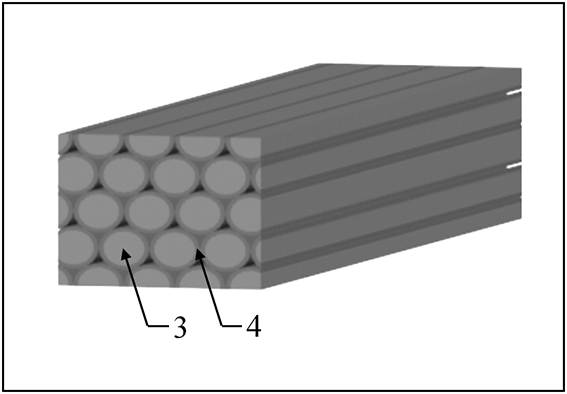Process for preparing weak interface fiber monolith hafnium boride ceramic by wet spinning and co-extrusion method
A technology of co-extrusion and monolithic boron, which is applied in the direction of wet spinning, spinning solution preparation, artificial filament of inorganic raw materials, etc., can solve the difficulty in forming fiber monolithic precursors, poor toughness of hafnium boride ultra-high temperature ceramics, etc. problem, to achieve the effect of thin diameter, fast dissolution speed and uniform thickness
- Summary
- Abstract
- Description
- Claims
- Application Information
AI Technical Summary
Problems solved by technology
Method used
Image
Examples
Embodiment 1
[0029]1. Preparation of fiber monolithic precursor cell body spinning slurry: First, stir and dissolve 10 grams of polyethersulfone and 1 gram of dioctyl phthalate in 80 grams of N-methylpyrrolidone and 20 grams of acetone, and then add fiber The ceramic powder of the monolithic precursor cell body and the ceramic powder of the fiber monolithic precursor cell body are made by mixing 70 grams of hafnium boride powder and 30 grams of silicon carbide powder according to the mass percentage of 70%: 30%, and stir evenly to make Fiber monolithic precursor cell body spinning slurry;
[0030] 2. Prepare fiber monolithic precursor interface layer spinning slurry: first stir and dissolve 10 grams of polyethersulfone and 1 gram of dioctyl phthalate in 160 grams of N-methylpyrrolidone and 40 grams of acetone, then add The ceramic powder for the interface layer of the fiber monolithic precursor, the ceramic powder for the interface layer of the fiber monolithic precursor is made by mixing ...
Embodiment 2
[0036] 1. Preparation of fiber monolithic precursor cell body spinning slurry: First, stir and dissolve 20 grams of polyethersulfone and 4 grams of dioctyl phthalate in 180 grams of N-methylpyrrolidone and 20 grams of acetone, and then add fiber The ceramic powder of the monolithic precursor cell body and the ceramic powder of the fiber monolithic precursor cell body are made by mixing 90 grams of hafnium boride powder and 10 grams of silicon carbide powder according to the mass percentage of 90%: 10%, and stir evenly to make Fiber monolithic precursor cell body spinning slurry;
[0037] 2. Preparation of fiber monolithic precursor interface layer spinning slurry: first stir and dissolve 20 grams of polyethersulfone and 4 grams of dioctyl phthalate in 450 grams of N-methylpyrrolidone and 50 grams of acetone, then add The ceramic powder for the interface layer of the fiber monolithic precursor, the ceramic powder for the interface layer of the fiber monolithic precursor is made...
Embodiment 3
[0043] 1. Preparation of fiber monolithic precursor cell body spinning slurry: First, stir and dissolve 15 grams of polyethersulfone and 2 grams of dioctyl phthalate in 125 grams of N-methylpyrrolidone and 25 grams of acetone, and then add fiber The ceramic powder of the monolithic precursor cell body and the ceramic powder of the fiber monolithic precursor cell body are made by mixing 80 grams of hafnium boride powder and 20 grams of silicon carbide powder according to the mass percentage of 80%: 20%, and stir evenly to make Fiber monolithic precursor cell body spinning slurry;
[0044] 2. Preparation of fiber monolithic precursor interface layer spinning slurry: first stir and dissolve 15 grams of polyethersulfone and 2 grams of dioctyl phthalate in 350 grams of N-methylpyrrolidone and 50 grams of acetone, then add The ceramic powder for the interface layer of the fiber monolithic precursor, the ceramic powder for the interface layer of the fiber monolithic precursor is mixe...
PUM
| Property | Measurement | Unit |
|---|---|---|
| diameter | aaaaa | aaaaa |
| thickness | aaaaa | aaaaa |
| bending strength | aaaaa | aaaaa |
Abstract
Description
Claims
Application Information
 Login to View More
Login to View More - R&D
- Intellectual Property
- Life Sciences
- Materials
- Tech Scout
- Unparalleled Data Quality
- Higher Quality Content
- 60% Fewer Hallucinations
Browse by: Latest US Patents, China's latest patents, Technical Efficacy Thesaurus, Application Domain, Technology Topic, Popular Technical Reports.
© 2025 PatSnap. All rights reserved.Legal|Privacy policy|Modern Slavery Act Transparency Statement|Sitemap|About US| Contact US: help@patsnap.com


